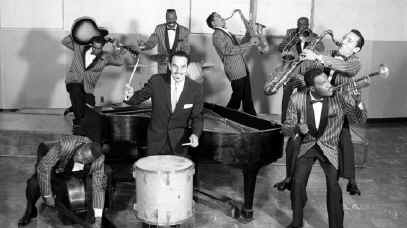
The Johnny Otis Show
Los Angeles, with several independent record
labels, was an important center in the development of rhythm and
blues.
Los Angeles, California was one of the most important places in
the world for the recorded music industry. During the 40s it had
a vibrant African American community.
"Now R&B started here in L.A.. Roy Milton was here,
Joe Liggins was here, T-Bone Walker was here, Charles Brown was
here, I was here, and others, too. By '48 or '49 it was set - we
had an art form, though we didn't know it then... It was a hybrid
form that began to emerge. It surely wasn't big band; it wasn't
swing; it wasn't country blues. It was what was to become known
as rhythm and blues, a hybrid form that became an art form in
itself. It was the foundation of rock and roll... Rock and roll
was a direct outgrowth of R&B. It took over all the things
that made R&B different from big band swing: the afterbeat on
a steady four; the influence of the boogie; the triplets on
piano; eight-to-the-bar on the top hat cymbal; and the shuffle
pattern of dotted eighth and sixteenth note"
Johnny Otis, bandleader and A&R man

Charles Brown was inducted into the Rock Hall in 1999 as an early influence.
This club blues was popularized by Nat "King" Cole trio in the Forties and carried on by other West Coat performers, including Charles Brown, Percy Mayfield, and a young Ray Charles.Soft club blues shared a popularity popularity with dancehall R&B bands on the West Coast, including Johnny Otis' Caravan of Stars, a touring company that was both of the last of the great big band touring groups - a single band that backed a number of singers - and the forerunner of the rock and roll packages that crisscrossed the country with a full rooster of stars.
![]()